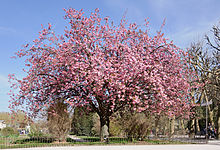Gracefulness
The etymological root of grace is the Latin word gratia from gratus, meaning pleasing.
In this ease, this roundness, this delicacy of attitude and motion, it is that all the magic of grace consists, and what is called its je ne sais quoi; as will be obvious to any observer, who considers attentively the Venus de Medicis, the Antinous, or any statue generally allowed to be graceful in an high degree.The difficulty in defining exactly what constitutes gracefulness is described in this analysis of Henri Bergson's use of the term: The organic form of drama is most clearly suggested in Bergson's use of the word 'gracefulness' [la grâce].
In this formulation, the soul, or what Bergson elsewhere calls the élan vital, the life force, shapes the matter that contains it.
For example, certain trees are commonly referred to as being "graceful", such as the Betula albosinensis, Prunus × yedoensis (Yoshino cherry), and Areca catechu (betel-nut palm).
Gracefulness is sometimes confused with gracility, or slenderness, although the latter word is derived from a different root, the Latin adjective gracilis (masculine or feminine), or gracile (neuter)[7] which in either form means slender, and when transferred for example to discourse, takes the sense of "without ornament", "simple", or various similar connotations.


